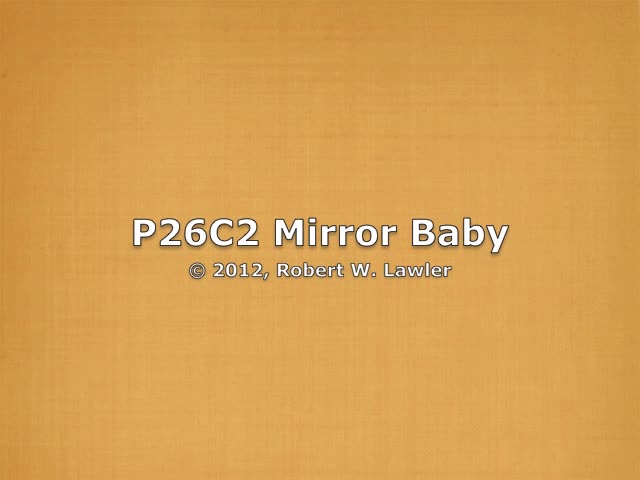
P26C2 Clip Notes
| Notes:n:nn | by Analyst, 11/03/2024 |
| Setting,Props | Cedar Hall, Family Room: |
| Actors,Aims | Peggy and Mom, Miriam; Bob on camera. |
| Episode A: | Mom: Hi, Peggy. Hi, there. [P responds enthusiastically] Mom: You want to play with the baby in the mirror again? Peggy: [wordless sounds of effort, grasping the clown] |
| Episode B: | Miriam: Hey, Daddy. Bob: Yes, Miriam. Miriam: Can I be Camera Lady for a while? Bob: Can you what? Miriam: Be Camera Lady of a while? Bob: No, I don’t… Miriam: Can I watch the TV for a while? [the TV displays the video recorded] Bob: Yes, you may. [M starts to cross in camera view] Bob: Come around that way. Don’t stand there. Over here by the piano. Miriam: When are we going to be over? a minute? |
| Episode C: | Peggy: [smiling at her image in the mirror] (makes a friendly sound, then a second — was this a response to Miriam’s question?) [end of clip] |
| Episode | |
| Summary by AI |
The clip features a baby named Peggy interacting with a mirror. An adult addresses Peggy warmly and invites her to play with the “baby in the mirror.” Peggy makes effortful, wordless sounds while grasping a clown toy. A child named Miriam addresses “Daddy.” Miriam asks to be the “Camera Lady,” leading to brief clarification. Miriam then asks if she can watch TV and receives permission. Miriam starts to cross into the camera’s view. The adult directs Miriam to move around by the piano to avoid blocking the shot. Someone asks, “When are we going to be over? In a minute?” suggesting impatience or timing inquiry. Peggy smiles at her reflection and makes friendly sounds that may be a response to Miriam’s question; the clip ends. |
| Narrative by AI |
A short home video captures a quiet domestic scene centered around a baby named Peggy. The clip opens with a cheerful greeting and a familiar prompt: an invitation to “play with the baby in the mirror again.” The atmosphere is casual and warm, suggesting a routine moment where the camera is part of everyday life, not a special event. Peggy appears focused on her reflection and a toy clown, making small, effortful sounds while grasping and exploring. The mirror play seems to hold her attention, drawing out expressive reactions—smiles and friendly noises directed at her own image. It’s a simple interaction that hints at early curiosity and self-recognition, framed by the gentle encouragement of an adult nearby. In the background, an older child, Miriam, enters the scene with her own request: to be the “Camera Lady.” After a brief exchange and some clarification, she pivots to another question—whether she can watch TV. Permission is granted, and she begins to move through the space, briefly crossing into the camera’s view. It’s a small moment that conveys the overlapping interests and movements of a household in motion. There’s also a bit of practical guidance from the adult: directions to avoid standing in front of the camera and to come around by the piano. The dialogue is matter-of-fact, managing the logistics of recording while keeping the children engaged. A question—“When are we going to be over?”—floats into the scene, suggesting the natural impatience that comes with waiting during an adult-led activity. The clip closes with Peggy smiling at her reflection and making a couple of friendly sounds, one of which might have been a response to Miriam’s question. Then it ends—an ordinary slice of family life preserved on camera. Nothing dramatic happens, yet the interactions reveal a lot: the baby’s engagement with the mirror, the sibling’s curiosity about the camera, and the gentle choreography of a parent guiding both. |
| Link Index | Panel P026, Language Development, Object Exploration, Social Interactions |
| Themes, Interplay |
